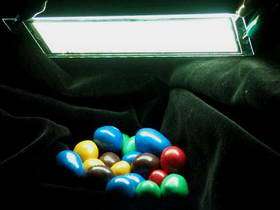Europe joins R&D forces on Organic LED technology for Lighting Applications

More than 20 of Europe’s leading companies and research establishments in organic electronics and materials as well as lighting applications, have joined together in OLLA* – an integrated R&D project to advance Organic Light-Emitting Diode (OLED) technologies. The project goal is to demonstrate in 2008 high-brightness white OLED light tiles for use in general lighting applications, with a long lifetime and high energy efficiency.
Image: Lighting tile with 35 cm2 active area using a white copolymer (Picture by Siemens)
OLEDs are a new and attractive class of solid-state light sources, which are opening up completely new applications in large-area illumination. OLEDs are flat light sources and could be made in future on flexible substrates. OLEDs could also be used in lighting systems with controllable color, allowing users to customize their light atmosphere at home. Furthermore, as a high efficient light source, the technology has the potential of achieving substantial energy savings.
“In recent years, OLED technology has improved to the point where it is now possible to envision OLEDs as the next solid-state light source. In order to make this happen, significant advances must still be made in device efficiency, lifetime at high brightness, high throughput fabrication processes, and the generation of illumination-quality white light. That’s exactly what we will do in OLLA. We will aim for a lifetime of 10,000 hours – which is 10 times longer than a standard incandescent bulb - and an efficiency of 50 lumens per Watt,” said Peter Visser of Philips, project manager of OLLA.
The project covers several important fields, including fundamental understanding of the materials and device aspects, electrical and optical properties of OLEDs, manufacturing principles and system integration. Several routes to make white light will be investigated. “A unique chance of the OLLA project is, that small-molecule devices as well as polymer LEDs are investigated side by side. Both approaches will definitely benefit from each other and this will bring OLED lighting forward to its realization” said Karsten Heuser of Siemens CT, responsible for the polymer deposition part within OLLA.
Application studies will complement the research efforts to match technology development with consumer interests. A separate work package for training and dissemination will serve as a platform to raise the awareness of lighting designers, architects and end-users about OLEDs and their possible use in lighting applications.
OLLA is one of the world’s largest joint research projects on the development of white OLEDs. It is partially funded under the IST (Information Society Technologies) priority of the European Union’s 6th Framework Programme. “This EU project complements other initiatives, such as the Next-Generation- Lighting Initiative in the USA and the Lighting21 program in Japan,” says Dietrich Bertram, OLLA’s technical coordinator. “OLLA brings together top-players in all aspects of OLED technology in Europe, allowing parallel progress on new materials, new device structures and innovative concepts for OLED manufacturing processes. This will speed up the technical development and provide the best possible basis to make OLEDs a commercially viable lighting technology,” Bertram of Philips Lighting said.
* OLLA: high brightness Organic Light emitting diodes for ICT & Lighting Applications
















